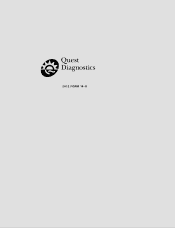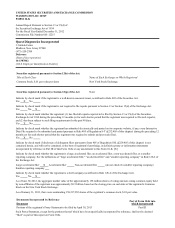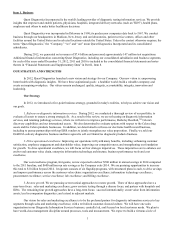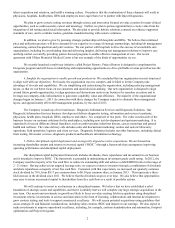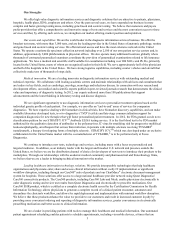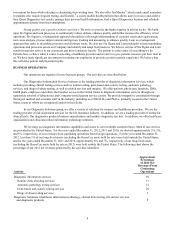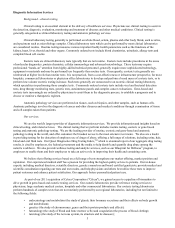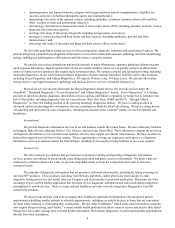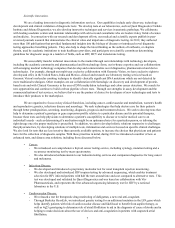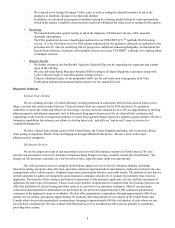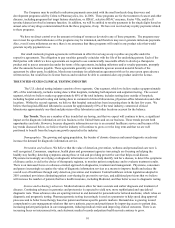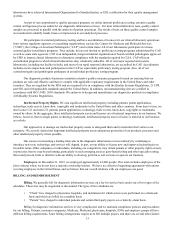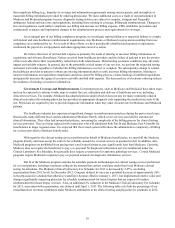Quest Diagnostics 2012 Annual Report Download - page 10
Download and view the complete annual report
Please find page 10 of the 2012 Quest Diagnostics annual report below. You can navigate through the pages in the report by either clicking on the pages listed below, or by using the keyword search tool below to find specific information within the annual report.
7
Scientific Innovation.
We are a leading innovator in diagnostic information services. Our capabilities include early discovery, technology
development and clinical validation of diagnostic tests. We develop tests at our laboratories, such as Quest Diagnostics Nichols
Institute and Athena Diagnostics; we also develop innovative techniques and services in anatomic pathology. We collaborate
with leading academic centers and maintain relationships with advisers and consultants who are leaders in key fields of science
and medicine. In connection with our research and development efforts, our medical and scientific experts publish in peer-
reviewed journals research that demonstrates the clinical value and importance of diagnostic testing. In 2012, they authored
more than 100 publications that provided fundamental insights into the biology of diseases or introduced novel diagnostic
testing approaches benefiting patients. They also help to shape the latest thinking as the authors of textbooks, or chapters
therein, used by academic institutions to train healthcare providers, and participate on scientific committees determining
guidelines for diagnostic usage in a number of fields, such as HIV, HCV and testosterone testing.
We successfully transfer technical innovations to the market through our relationships with technology developers,
including the academic community and pharmaceutical and biotechnology firms, our in-house expertise and our collaborations
with emerging medical technology companies that develop and commercialize novel diagnostics, pharmaceutical and device
technologies. For example, through our multi-year exclusive collaboration with Genomic Vision, we have exclusive rights to
develop and offer, in the United States, India and Mexico, clinical and research use laboratory testing services based on
Genomic Vision's molecular combing technique to identify clinically significant DNA mutations which are not detected by
more traditional techniques. Other examples are our collaboration with Somalogic on discovery and development of protein-
based tests and with Clinical Genomics in the area of DNA methylation technology and colon cancer detection. We search for
new opportunities and continue to build a robust pipeline of new tests. Through our strengths in assay development and the
commercialization of test services, we believe that we are the partner of choice for developers of new technologies and tests to
introduce their products to the marketplace.
We are organized to focus on key clinical franchises, including cancer, cardiovascular and metabolism, women's health
and reproductive genetics, infectious disease and neurology. We seek technologies that help doctors care for their patients
through better predisposition, screening, monitoring, diagnosis, prognosis and treatment choices. We seek to develop tests that
help to determine a patient's genotype or gene expression profile relative to a particular disease and its potential therapies,
because these tests can help physicians to determine a patient's susceptibility to disease or to tailor medical care to an
individual's needs - such as determining if a medication might be an optimum choice for a particular person, or tailoring the
right dosage once the proper medicine is prescribed. In addition, we aim to develop holistic solutions responsive to challenges
that physicians face, by developing solutions of multiple tests, information and services focused on specific clinical challenges.
We also look for tests that are less invasive than currently available options, to increase the choices that physicians and patients
have for the collection of diagnostic samples. With these priorities in mind, during 2012 we introduced a number of new or
enhanced tests, and disease area solutions, including those discussed below.
•Cancer.
- We introduced our comprehensive thyroid cancer testing service, including cytology, mutation testing and a
recurrence monitoring test by mass spectrometry.
- We also introduced enhancements to our leukemia testing services and companion diagnostics for lung cancer
and melanoma.
•Infectious Disease.
- We developed and introduced a proprietary molecular test for renal transplant rejection monitoring.
- We also developed and introduced HIV tropism testing by advanced sequencing, which enables treatment
selection for HIV infected patients with half the turn around time and cost compared to alternative tests. This
test was developed and validated by Quest Diagnostics and was based on collaboration with Viiv
Pharmaceuticals, and represents the first advanced sequencing laboratory test for HIV by a national
laboratory in the U.S.
•Cardiovascular Disease.
- We released a test for therapeutic drug monitoring of dabigatran, a new oral anti-coagulant.
- Through Berkeley HeartLab, we introduced genetic testing for an additional mutation in the LPA gene which
helps identify patients with risk of cardiovascular disease and likelihood to benefit from aspirin therapy, as
well as 4q25 genotyping to determine risk of atrial fibrillation to aid in the diagnosis of cause of stroke and in
helping to make decisions about the use of devices and anti-coagulation in patients with suspected atrial
fibrillation.

